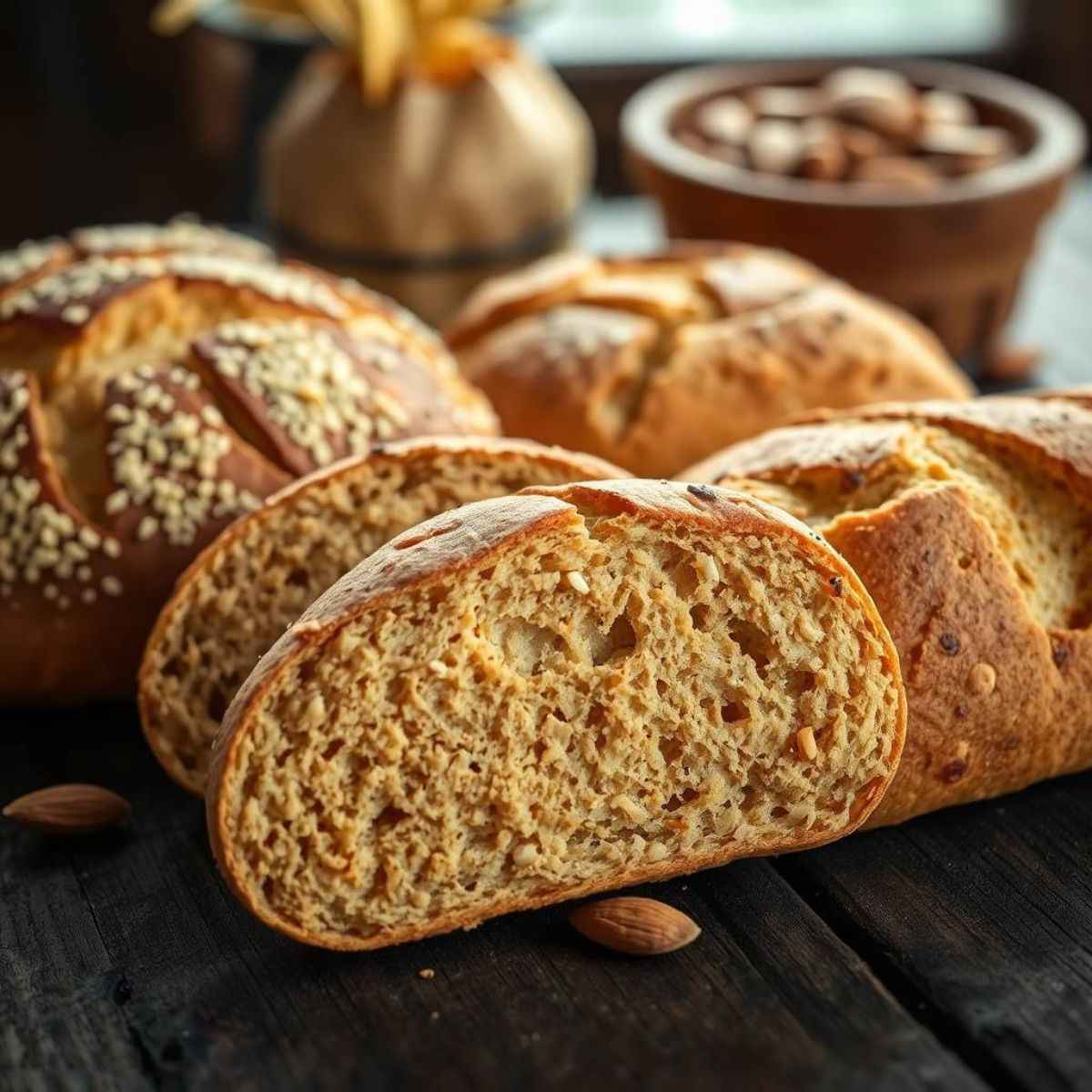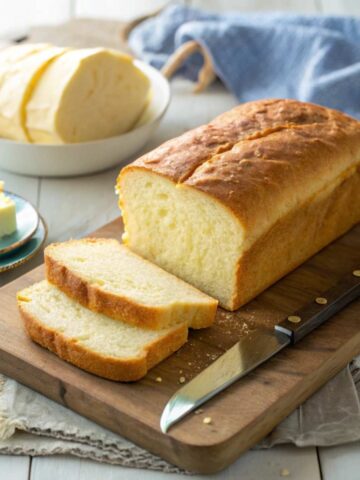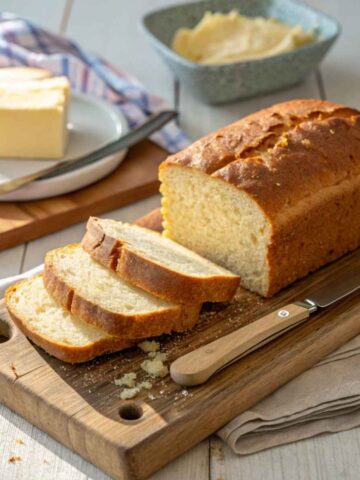If you’ve ever wondered what type of bread is gluten-free, you’re not alone. With the rise of gluten-free diets, more people are exploring alternatives to traditional bread. GF bread offers a solution for individuals with gluten intolerance, celiac disease, or those who simply prefer to avoid gluten. But what exactly qualifies as gluten-free bread, and what makes it different? Let’s dive in and uncover everything you need to know about GF bread.

Jump to:
Benefits of Gluten-Free Bread
1. Health Benefits
GF bread offers numerous benefits for those who need it:
- Reduces inflammation in people with gluten-related disorders.
- Promotes better digestion and gut health for those with gluten sensitivities.
- Provides a safe bread option for individuals with wheat or related grains allergies.
2. Suitable for Specific Diets
- Celiac Disease: Provides a necessary alternative for a safe, balanced diet.
- Low-FODMAP Diets: Many gluten-free breads align with low-FODMAP guidelines, which are helpful for individuals managing irritable bowel syndrome (IBS).
3. Nutritional Customization
Gluten-free bread is often enriched with additional nutrients, such as fiber and protein, making it a valuable addition to specific dietary requirements. Flours like almond or buckwheat provide more nutrients than traditional wheat.
Ingredients Used in Gluten-Free Bread
To replicate the texture and flavor of traditional bread, GF bread uses innovative combinations of gluten-free flour, starches, and binders.
Common Gluten-Free Flours:
- Rice Flour: A neutral, versatile base for GF bread.
- Almond Flour: Adds moisture, protein, and a nutty flavor.
- Buckwheat Flour: Despite its name, it’s gluten-free and has an earthy flavor.
- Tapioca Flour: Enhances elasticity and chewiness.
- Sorghum Flour: Provides a mild sweetness and improves structure.
Binders and Stabilizers:
Without gluten to provide elasticity, gluten-free bread often includes:
- Xanthan Gum or Guar Gum: Improves the dough’s texture and binding.
- Eggs: Often used in recipes to add moisture and structure.
Optional Additives:
- Seeds and Nuts: Chia, flax, or sunflower seeds enhance flavor and nutrition.
- Sweeteners: Like honey or agave for flavor balance.
Rice flour is a popular choice in gluten-free baking. Curious about whether rice is completely gluten-free? Read our detailed post: Is Rice Gluten-Free? A Complete Guide.
Types of Gluten-Free Bread
Gluten-free bread comes in a variety of forms, catering to different tastes, occasions, and dietary needs. For instance, from soft sandwich bread to artisan-style loaves, there’s truly something for everyone seeking to avoid gluten.
1. Sandwich Bread
- Characteristics: Soft, light, and perfect for everyday use.
- Uses: Ideal for sandwiches, toast, or as a side with meals.
- Examples: Pre-sliced loaves from brands like Udi’s or Canyon Bakehouse.
2. Artisan Bread
- Characteristics: Crusty on the outside, tender on the inside, with a more rustic appearance.
- Uses: Great for dipping in olive oil, pairing with soups, or serving at dinner parties.
- Examples: Specialty bakery breads or homemade loaves using sorghum or almond flour.
3. Sourdough
- Characteristics: A tangy flavor from natural fermentation. Not all sourdough is gluten-free, so labels must be checked carefully.
- Uses: Perfect for sandwiches, avocado toast, or as a snack.
4. Flatbread
- Characteristics: Thin and versatile, often resembling tortillas or naan.
- Uses: Great for wraps, pizzas, or as a side for curries and stews.
- Examples: GF pita bread, and corn tortillas.
5. Sweetbread
- Characteristics: Often includes natural sweeteners and flavorings like cinnamon, raisins, or banana.
- Uses: Breakfast or dessert.
- Examples: Gluten-free banana bread or cinnamon raisin loaves.
6. Pre-packaged vs. Homemade
- Pre-Packaged Bread: Convenient, consistent, but often pricier.
- Homemade Bread: Customizable, fresher, and free from preservatives, though it requires effort and time.
Popular Brands of Gluten-Free Bread
Nowadays, many companies specialize in creating high-quality gluten-free bread. As a result, here are some of the most trusted brands you can rely on:
1. Udi’s Gluten-Free
- Overview: A leader in GF products offering a wide range of bread options, including sandwich loaves and bagels.
- Pros: Consistent quality, soft texture, easily accessible.
- Cons: Higher price point and some preservatives.
2. Canyon Bakehouse
- Overview: Known for its artisan-style loaves and clean ingredients.
- Pros: Great taste and texture, non-GMO, and often dairy-free.
- Cons: Short shelf life without freezing.
3. Schär
- Overview: A European favorite with a wide selection of gluten-free baked goods.
- Pros: Long shelf life, available in pre-sliced varieties.
- Cons: Slightly dense texture compared to competitors.
4. Simple Mills
- Overview: Focuses on natural, wholesome ingredients.
- Pros: Nutrient-rich flours like almond or coconut, paleo-friendly.
- Cons: Smaller loaves and less variety.
How to Make Gluten-Free Bread at Home
Homemade gluten-free bread allows for complete control over ingredients and flavor. Here’s a step-by-step guide to baking your loaf.
Ingredients
- 2 cups rice flour
- 1 cup tapioca flour
- 1/2 cup almond flour
- 1 teaspoon xanthan gum
- 1 packet (2 1/4 tsp) instant yeast
- 2 tablespoon sugar
- 1 1/2 cups warm water
- 2 large eggs (or flaxseed substitute for vegans)
- 1/4 cup olive oil
- 1 teaspoon salt
Instructions
- Activate the Yeast: Mix warm water, sugar, and yeast in a bowl. Let it sit for 5–10 minutes until foamy.
- Combine Dry Ingredients: In a separate bowl, whisk rice flour, tapioca flour, almond flour, xanthan gum, and salt.
- Mix Wet Ingredients: Add eggs and olive oil to the yeast mixture. Stir well.
- Combine: Gradually add dry ingredients to the wet mixture, stirring until a thick batter forms.
- Let It Rise: Pour batter into a greased loaf pan. Cover and let rise for 1 hour in a warm spot.
- Bake: Preheat the oven to 375°F (190°C). Bake for 30–40 minutes until golden brown.
- Cool: Let the bread cool before slicing.
Tips for Success
- Texture Matters: Gluten-free dough is more like batter; don’t expect a traditional kneading process.
- Storage: Keep homemade bread in the fridge or freezer to extend its shelf life.
Making gluten-free bread at home allows for complete control over ingredients and freshness. If you're looking for a step-by-step guide, check out our recipe for Soft, Delicious, and Easy Gluten-Free Bread.
Challenges with Gluten-Free Bread
Despite its many benefits, gluten-free bread comes with its own set of challenges that consumers should be aware of.
1. Taste and Texture Issues
- Taste: GF bread can have a slightly different flavor due to alternative flours like rice or buckwheat. Some varieties may taste bland or overly dense.
- Texture: Without gluten, achieving the elastic and airy texture of traditional bread can be difficult. Some loaves may feel crumbly or dry.
2. Cost Considerations
- In comparison to regular bread, gluten-free bread is often more expensive. This is primarily due to the higher cost of specialty ingredients and the additional requirements for dedicated gluten-free facilities.
- Consumers on a budget may need to explore homemade options to save money.
3. Shelf Life
- Most gluten-free bread lacks the preservatives found in conventional bread, leading to a shorter shelf life.
- Solutions include freezing the bread to extend its usability or purchasing fresh, smaller batches.
4. Cross-Contamination Risks
- For those with celiac disease, cross-contamination during manufacturing or preparation can be a serious concern. Opting for certified gluten-free brands and home baking minimizes this risk.
Gluten-Free Bread in Restaurants
Dining out as a gluten-free individual can be a rewarding experience, but it requires careful planning.
1. Gluten-Free Options in Restaurants
Many restaurants now offer gluten-free bread alternatives for sandwiches, burgers, and side dishes. However, options vary depending on the establishment:
- Casual Eateries: Often provide GF buns for burgers or wraps.
- Fine Dining: May offer artisan-style gluten-free bread as part of the breadbasket or with entrees.
2. Tips for Safe Dining Out
- Ask Questions: Confirm with staff if the bread is made in a gluten-free facility and inquire about cross-contamination practices.
- Avoid Shared Equipment: Request that the bread not be toasted or handled on surfaces shared with regular bread.
- Look for Certifications: Many restaurants advertise gluten-free certifications on their menu or website, indicating safer preparation practices.
3. Recognizing Cross-Contamination Risks
- Kitchen Practices: Shared utensils, surfaces, and toasters can introduce gluten into GF bread.
- Baking Methods: Some restaurants may use the same ovens or preparation areas for gluten-free and regular bread, posing risks for sensitive individuals.
Dining out gluten-free can be challenging, but you can recreate some restaurant favorites at home! Explore our tips in Gluten-Free Fast Food Options: DIY at Home.
FAQs and Myths About Gluten-Free Bread
The primary difference lies in the absence of gluten in GF bread. Regular bread relies on gluten to provide elasticity and structure, while GF bread uses alternative flour and binders to achieve a similar result.
GF bread often tastes and feels a bit different from regular bread. However, improvements in recipes and ingredients have made it much closer to traditional bread. Artisan gluten-free bread and homemade versions can be very similar in flavor.
Some of the top brands, for example, include Udi’s, Canyon Bakehouse, and Schär. Notably, these brands are known for offering high-quality gluten-free bread with a wide variety of options, such as sandwich loaves and artisan bread.
No, not all sourdough bread is GF. While the fermentation process in sourdough reduces gluten content, most sourdough bread made with wheat flour is not safe for those with celiac disease. Look for certified gluten-free sourdough.
Not necessarily. GF bread is essential for those with gluten-related disorders but may not benefit others significantly. Some GF bread may lack the fiber and nutrients found in whole-grain wheat bread.
Did you know that not all sourdough bread is gluten-free? Learn more about the distinctions in our post: Is Sourdough Bread Gluten-Free? A Comprehensive Guide.
Want to try making your gluten-free sourdough? Follow our guide to creating a Gluten-Free Sourdough Starter from scratch.
Conclusion
Over the years, gf bread has become a staple for individuals managing celiac disease, gluten intolerance, or even for those simply exploring a gluten-free lifestyle. Moreover, with various types available—such as sandwich bread, artisan loaves, and sourdough there’s truly an option to suit every taste and need. Advances in recipes and ingredients have improved the taste and texture of gluten-free bread, though challenges like cost, shelf life, and cross-contamination remain.
For those interested in taking control of their diet, making GF bread at home offers a rewarding and customizable experience. Whether you choose pre-packaged brands, bakery options, or homemade loaves, the key is to find what works best for your health and lifestyle.





Leave a Reply